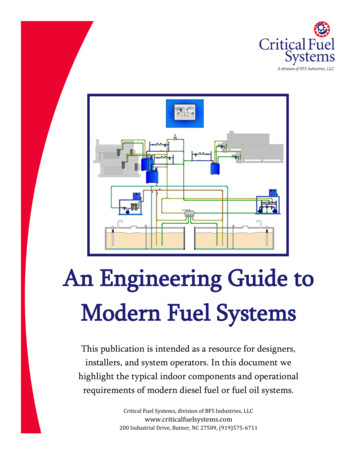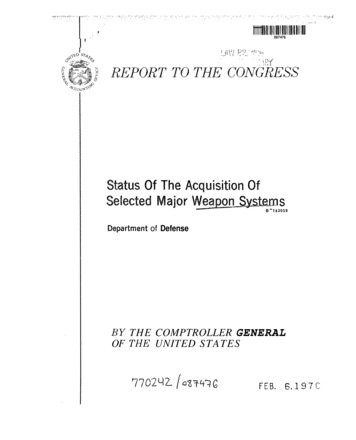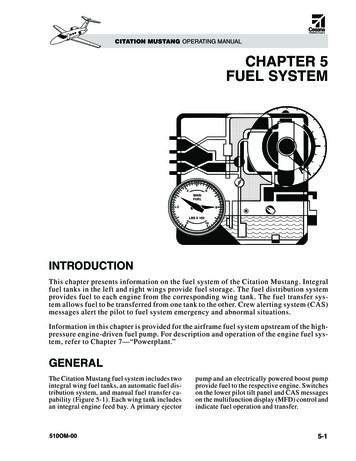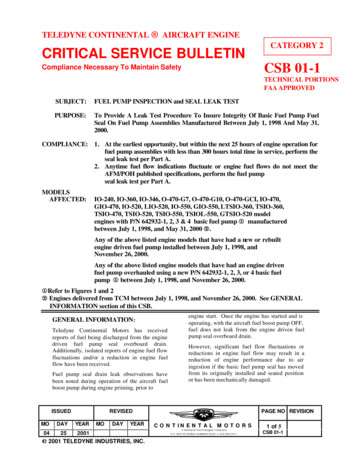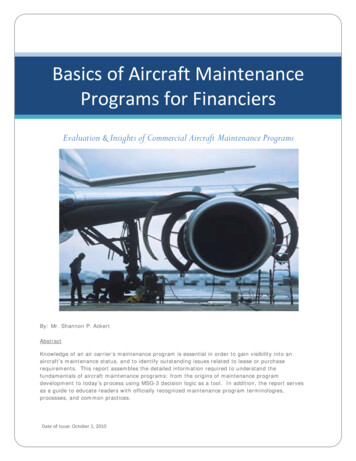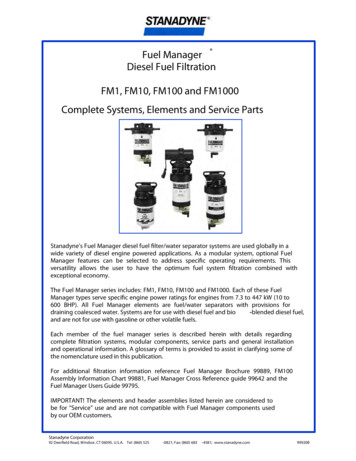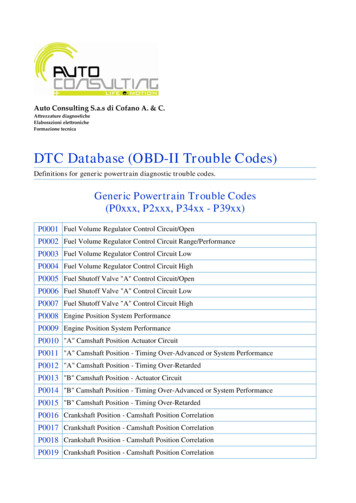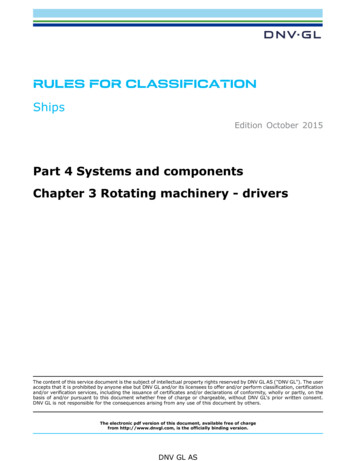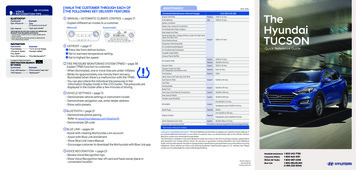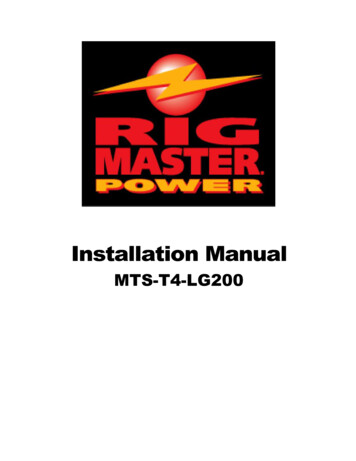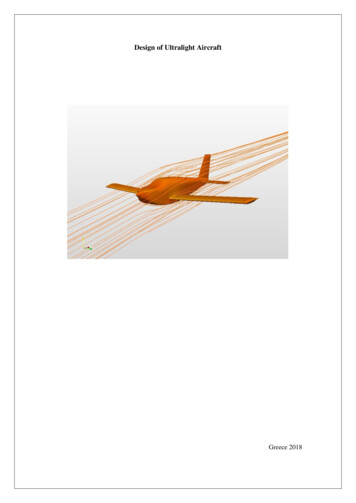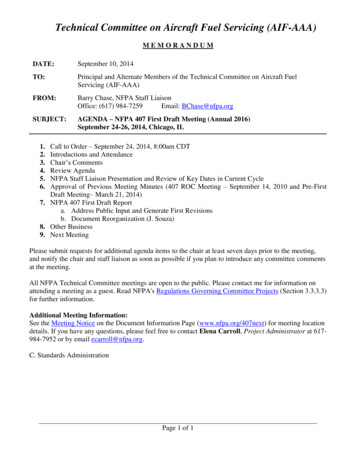
Transcription
Technical Committee on Aircraft Fuel Servicing (AIF-AAA)MEMORANDUMDATE:September 10, 2014TO:Principal and Alternate Members of the Technical Committee on Aircraft FuelServicing (AIF-AAA)FROM:Barry Chase, NFPA Staff LiaisonOffice: (617) 984-7259Email: BChase@nfpa.orgSUBJECT:AGENDA – NFPA 407 First Draft Meeting (Annual 2016)September 24-26, 2014, Chicago, ILCall to Order – September 24, 2014, 8:00am CDTIntroductions and AttendanceChair’s CommentsReview AgendaNFPA Staff Liaison Presentation and Review of Key Dates in Current CycleApproval of Previous Meeting Minutes (407 ROC Meeting – September 14, 2010 and Pre-FirstDraft Meeting– March 21, 2014)7. NFPA 407 First Draft Reporta. Address Public Input and Generate First Revisionsb. Document Reorganization (J. Souza)8. Other Business9. Next Meeting1.2.3.4.5.6.Please submit requests for additional agenda items to the chair at least seven days prior to the meeting,and notify the chair and staff liaison as soon as possible if you plan to introduce any committee commentsat the meeting.All NFPA Technical Committee meetings are open to the public. Please contact me for information onattending a meeting as a guest. Read NFPA's Regulations Governing Committee Projects (Section 3.3.3.3)for further information.Additional Meeting Information:See the Meeting Notice on the Document Information Page (www.nfpa.org/407next) for meeting locationdetails. If you have any questions, please feel free to contact Elena Carroll, Project Administrator at 617984-7952 or by email ecarroll@nfpa.org.C. Standards AdministrationPage 1 of 1
COMMITTEE ROSTER(AIF-AAA)
09/08/2014Barry D. ChaseAIF-AAAAddress List No PhoneAircraft Fuel ServicingFred A. CnotaChairChicago Fire DepartmentChicago O'Hare Airport6934 West Highland AvenueChicago, IL 60631-1735Alternate: Cristino Colon, Jr.John H. BagnallPrincipalBurns & McDonnell Engineering CompanyPO Box 419173Kansas City, MO 64141Alternate: Kenneth M. BilsonE 7/12/2001 Jeremy SouzaAIF-AAA SecretaryRhode Island Airport CorporationT. F. Green Airport Fire-Rescue2000 Post roadWarwick, RI 02886SE 1/15/2004 Terry L. BossermanAIF-AAA PrincipalBosserman Aviation Equipment, Inc.2327 State Route 568Carey, OH 43316-9583Mark BourdeauPrincipalUnited Airlines Inc.1200 East Algonquin RoadElk Grove Township, IL 60007C 7/23/2008 Michael D. ButlerAIF-AAA PrincipalURS Corporation7650 West Courtney Campbell CausewayTampa, FL 33607-1462Alternate: Charles A. DavisPaul E. CalderwoodPrincipalCity of Everett Fire Department10311 Inwood DriveWoburn, MA 01801E 7/26/2007 Haydee CarltonAIF-AAA PrincipalAmerican Airlines3900 North Mingo RoadTulsa, OK 74116-5000Roy CreleyPrincipalLakes Region Environmental Inc.PO Box 1236Belmont, NH 03220M 10/27/2009 John J. DemyanAIF-AAA PrincipalLehigh-Northampton Airport Authority1343 North Tacoma StreetAllentown, PA 18109Christopher L. DukesPrincipalTitan Aviation5-197, Mina Al ArabRas Al Khaimah, 33638 United Arab EmiratesM 7/22/1999 Dan FrankAIF-AAA PrincipalArgus Consulting, Inc.1300 NW Jefferson Court, Suite 100Blue Springs, MO 64015Thomas D. GambinoPrincipalPrime Engineering, Inc.3715 Northside Parkway, N.W300 Northcreek, Suite 200Atlanta, GA 30327SE 10/3/2002 Howard M. GammonAIF-AAA PrincipalGammon Technical Products Inc.2300 Highway 34Manasquan, NJ 08736-0400Alternate: James GammonE 8/2/2010AIF-AAAM 7/15/1992AIF-AAASE 08/11/2014AIF-AAAC 7/26/2007AIF-AAAE 8/2/2010AIF-AAASE 07/29/2013AIF-AAAM 1/1/1986AIF-AAA1
09/08/2014Barry D. ChaseAIF-AAAAddress List No PhoneAircraft Fuel ServicingNathan R. GerlichPrincipalSouthwest Airlines CompanyPO Box 36611, HDQ-7FMDallas, TX 75235C 3/2/2010 Michael KluttzAIF-AAA PrincipalRobert and Company229 Peachtree Street, NEInternational Tower Suite 2000Atlanta, GA 30303Alternate: Larry BeasleySE 1/1/1987AIF-AAAMichael LoveridgePrincipalAircraft Service International GroupPO Box 66131Chicago, IL 60666U 8/5/2009 William E. MoodyAIF-AAA PrincipalAir BP150 West Warrenville RoadNaperville, IL 60563-8473American Petroleum InstituteAlternate: John C. ThurstonU 07/29/2013AIF-AAAMichael MotschmanPrincipalServisair & Shell Fuel Services10600 West Higgins, Suite 606Rosemont, IL 60018Alternate: Carl D. CrosleyU 10/27/2009 Aldo NuzzoleseAIF-AAA PrincipalPort Authority of New York & New Jersey241 Erie Street, Room 307Jersey City, NJ 07310U 1/15/2004AIF-AAAPaul ParadisPrincipalDefense Contract Management Agency3484 Wainwright StreetSaint Charles, MO 63301Alternate: Hal Douglas WhiteE 03/03/2014 Ronald F. PattieAIF-AAA PrincipalSkytanking USA Inc.910 SE 17th Street, Suite 201Ft. Lauderdale, FL 33316U 10/1/1999AIF-AAADana W. PotterPrincipalMassport Fire DepartmentBoston-Logan International Airport1 Harborside Drive, Suite 200SEast Boston, MA 02128-2905E 07/29/2013 Cary SkinnerAIF-AAA PrincipalAviation Fire Safety Consultants Inc.5939 North West Circle AvenueChicago, IL 60631Fred J. StipkovitsPrincipalGarsite Aviation Refueling Equipment539 South 10th StreetKansas City, KS 66105Larry S. WeaverPrincipalDellem Associates Inc.16115 East Course DriveTampa, FL 33624-1123M 3/1/2011 Steve ThickstunAIF-AAA PrincipalAdvanced Fuel Systems841 Alton AvenueColumbus, OH 43219SE 07/29/2013 Larry BeasleyAIF-AAA AlternateRobert and CompanyInternational Tower, Suite 2000229 Peachtree Street, NEAtlanta, GA 30303Principal: Michael KluttzSE 03/07/2013AIF-AAAM 10/29/2012AIF-AAASE 7/26/2007AIF-AAA2
09/08/2014Barry D. ChaseAIF-AAAAddress List No PhoneAircraft Fuel ServicingKenneth M. BilsonAlternateBurns & McDonnell Engineering Company3650 Mansell Road, Suite 300Alpharetta, GA 30022-3068Principal: John H. BagnallSE 08/11/2014 Cristino Colon, Jr.AIF-AAA AlternateChicago Fire Department4059 West OakdaleChicago, IL 60641Principal: Fred A. CnotaCarl D. CrosleyAlternateServisair Fuel Services151 Northpoint DriveHouston, TX 77060-3207Principal: Michael MotschmanU 07/26/2007 Charles A. DavisAIF-AAA AlternateURS Corporation7650 West Courtney Campbell CausewayTampa, FL 33607-1462Principal: Michael D. ButlerJames GammonAlternateGammon Technical Products Inc.2300 Highway 34PO Box 400Manasquan, NJ 08736Principal: Howard M. GammonM 03/07/2013 John C. ThurstonAIF-AAA AlternateAir BP28301 Ferry RoadWarrenville, IL 60555American Petroleum InstitutePrincipal: William E. MoodyHal Douglas WhiteAlternateDefense Contract Mganagement Agency2720 Howitzer Street, 3rd FloorFort Sam Houston, TX 78234Principal: Paul ParadisE 03/03/2014 Barry D. ChaseAIF-AAA Staff LiaisonNational Fire Protection Association1 Batterymarch ParkQuincy, MA 02169-7471E 10/27/2009AIF-AAASE 10/1/1996AIF-AAAU 1/1/1991AIF-AAA7/29/2010AIF-AAA3
MEETING MINUTES(Sept. 14, 2010 ROC)
NFPA 407 A11 ROC MEETING MINUTESTechnical Committee on Aircraft Fuel ServicingTuesday, September 14, 2010Microsoft Live Meeting/Conference Call1. Meeting called to order by Fred Cnota at 12:10pm EST2. Roll was called.Attendees (P Principal, A Alternate, G Guest):Fred Cnota, P (Chair)Jeremy Souza, P (Secretary)Terry Bosserman, PPaul Calderwood, PRoy Creley, PJohn Demyan, PMichael Kluttz, PMichael Loveridge, PMichael Motschman, PAldo Nuzzolese, PCristino Colon, A (Alt. to Fred Cnota)Carl Crosley, A (Voting for Haydee Carlton)Rick Hutson (ASA), GJonathan Levin, NFPA StaffBarry Chase, NFPA Staff3.4.5.6.7.Jeremy Souza was elected Secretary of the Committee.Meeting minutes accepted from previous meetingPublic comments were reviewed and addressedThe Task Group on Bonding Procedure reported and was dissolved with no committee action.The Task Group on Tunnel Use reported and the committee addressed the recommendedactions.8. Meeting opened to members for additional Committee CommentsA Task Group was created to research the requirements for alternative‐fuel fueling vehiclesand electronic components on fuel vehicles and to determine whether the material may bejustifiably added at the Comment stage. The Task Group consisted of: Aldo Nuzzolese, Port Authority of New York and New Jersey (chair)Terry Bosserman, Bosserman Aviation Equipment, Inc
Fred Cnota, Chicago Fire DepartmentJohn Demyan, Lehigh‐Northampton Airport AuthorityChris Colon, Chicago Fire DepartmentChris Dukes, Garsite, Inc (potential)Alternative Fueled Vehicles Task Group will report back to the full committee by October 15,2010 at the latest with the results of their research.9. Next meeting tentatively scheduled for Wednesday, October 20th, to hear the report of the TaskGroup on Alternative‐Fuel Vehicles. Should the meeting not be needed, an email will be sent tocancel prior to the meeting.10. The meeting was adjourned by Fred Cnota at 2:32pm.Respectfully submitted,Jeremy Souza
MEETING MINUTES(March 31, 2014 Pre-FD)
NFPA 407 Pre- First Draft Meeting MinutesTechnical Committee on Aircraft Fuel ServicingFriday, March 31, 2014Conference Call / Adobe Connect web meeting1.The meeting was called to order by Fred Cnota at 1:06 PM Eastern Time2.The roll was called showing 18 total attendees:Fred Cnota P (Chair)Jeremy Souza P (Secretary)John Bagnall PTerry Bosserman PRoy Creley PCharles Davis PDan Frank PThomas Gambino PMichael Kluttz PMichael Loveridge PMichael Motschman PMichael Nightingale PAldo Nuzzolese PDana Potter PMike Butler (URS Corporation) (guest)Barry Chase (NFPA Staff Liasion)Audrey Goldstein (NFPA staff)Jacqueline Wilmot (NFPA staff)3.The meeting agenda was reviewed by Fred Cnota.4. Staff Liaison Barry Chase presented NFPA updates to the standards revision process5. Jeremy Souza presented a proposal for a complete rewrite/reorganization of NFPA 407 (attached inthe agenda).At the request of Fred Cnota, the committee, as a whole, was tasked to read and comment onthe revised NFPA 407 and to have the comments in by June 1, 2014 to Jeremy Souza.6. Electronic cigarette requirements will be added in as a public comment from the originator.
7. Spark arrestors on fuel injected gasoline engine requirements will be added in as a public commentfrom the originator.8. Labeling on tanker cab and fuel facilities will be added in as a public comment from the originator.9. API 1529 (now known as EI 1529) changes will be addressed through public comments or at the FirstDraft meeting.10. Other business: none.11. Prospective date for the First Draft Meeting will be September 24, 25, and 26, 2014 in the Chicagoarea.12. The meeting was adjourned at 2:00PM Eastern time.Respectfully submitted;Jeremy Souza, Secretary
Public Input
National Fire Protection Association Report1 of etcher?commentPara.Public Input No. 32-NFPA 407-2014 [ Chapter 2 ]Chapter 2 Referenced Publications2.1 General.The documents or portions thereof listed in this chapter are referenced within this standard and shall beconsidered part of the requirements of this document.2.2 NFPA Publications.National Fire Protection Association, 1 Batterymarch Park, Quincy, MA 02169-7471.NFPA 10, Standard for Portable Fire Extinguishers, 2010 edition 2013 .NFPA 30, Flammable and Combustible Liquids Code, 2012 edition .NFPA 70 , National Electrical Code , 2011 edition 2014 .NFPA 385, Standard for Tank Vehicles for Flammable and Combustible Liquids, 2007 edition 2012 .NFPA 410, Standard on Aircraft Maintenance, 2010 edition .NFPA 415, Standard on Airport Terminal Buildings, Fueling Ramp Drainage, and Loading Walkways, 2008edition 2013 .NFPA 418, Standard for Heliports, 2011 edition .2.3 Other Publications.2.3.1 API EI Publications.American Petroleum Energy Institute, 1220 L 61 New Cavendish Street, N.W., Washington, DC20005-4070.API BULL London W1G 7AR, UK .EI 1529, Aviation Fueling Hose , 1998 and Hose Assemblies , 6thedition, 2005 .2.3.2 ASME Publications.ASME International , 3 Park Avenue, New York NY 10016-5990.ANSI/ ASME B31.3, Process Piping, 2008 2012 .2.3.3 ASTM Publications.ASTM International, 100 Barr Harbor Drive, P.O. Box C700, West Conshohocken, PA 19428-2959.ASTM D 380, Standard Test Methods for Rubber Hose, 1994, Revised 2006 Reapproved 2012 .2.3.4 AWS Publications.American Welding Society, 550 N.W. LeJeune Road 8669 NW 36 Street , Miami, FL 33126 33166-6672 .AWS A5.10, Specification for Bare Aluminum and Aluminum Alloy Welding Electrodes and Rods, 1999,Revised 2007 2010 .2.3.5 UL Publications.Underwriters Laboratories Inc., 333 Pfingsten Road, Northbrook, IL 60062-2096.ANSI/ UL 913, Standard for Intrinsically Safe Apparatus and Associated Apparatus for Use in Class I, II,thand III Division 1, Hazardous (Classified) Locations, 2006, Revised 2010 8edition, 2013 .2.3.6 U.S. Government Publications.U.S. Government Printing Office, Washington, DC 20402.Title 49, Code of Federal Regulations, 1998, Revised 2003.2.3.7 Other Publications.Merriam-Webster’s Collegiate Dictionary, 11th edition, Merriam-Webster, Inc., Springfield, MA, 2003,Revised 2006.2.4 References for Extracts in Mandatory Sections.NFPA 385, Standard for Tank Vehicles for Flammable and Combustible Liquids,2007 edition 2012 .9/5/2014 11:57 AM
National Fire Protection Association Report2 of etcher?commentPara.Statement of Problem and Substantiation for Public InputUpdated to current editions and change in address for American Welding Society.Related Public Inputs for This DocumentRelated InputRelationshipPublic Input No. 33-NFPA 407-2014 [Chapter C]Submitter Information VerificationSubmitter Full Name: Aaron AdamczykOrganization:[ Not Specified ]Street Address:City:State:Zip:Submittal Date:Tue Jun 10 23:52:52 EDT 20149/5/2014 11:57 AM
National Fire Protection Association Report3 of etcher?commentPara.Public Input No. 36-NFPA 407-2014 [ Section No. 2.3.3 ]2.3.3 ASTM Publications.ASTM International, 100 Barr Harbor Drive, P.O. Box C700, West Conshohocken, PA 19428-2959.ASTM D 380, Standard Test Methods for Rubber Hose, 1994, Revised 2006 94( 2012) .Statement of Problem and Substantiation for Public InputUpdate the year date for standard(s)Submitter Information VerificationSubmitter Full Name: Steve MawnOrganization:ASTM InternationalStreet Address:City:State:Zip:Submittal Date:Mon Jul 07 10:40:00 EDT 20149/5/2014 11:57 AM
National Fire Protection Association Report4 of etcher?commentPara.Public Input No. 7-NFPA 407-2013 [ Section No. 2.3.3 ]2.3.3 ASTM Publications.ASTM International, 100 Barr Harbor Drive, P.O. Box C700, West Conshohocken, PA 19428-2959.ASTM D 380, Standard Test Methods for Rubber Hose, 1994, Revised 2006.ASTM D 2276, Standard Test Method for Particulate Contaminant in Aviation Fuel Line by Line Sampling ,2006.Additional Proposed ChangesFile Name407 Trumble.pdfDescription ApprovedCover SheetStatement of Problem and Substantiation for Public InputNFPA 407 lacks mention of testing fuel for fuel contamination. Minimizing the contaminants in aviation fuel reducesthe probability of filter plugging and other operational flight safety issues.Submitter Information VerificationSubmitter Full Name: Christopher TrumbleOrganization:US Army Aviation & Missile CommandStreet Address:City:State:Zip:Submittal Date:Thu May 02 13:12:17 EDT 20139/5/2014 11:57 AM
National Fire Protection Association Report5 of etcher?commentPara.Public Input No. 8-NFPA 407-2013 [ Section No. 2.3.3 ]2.3.3 ASTM Publications.ASTM International, 100 Barr Harbor Drive, P.O. Box C700, West Conshohocken, PA 19428-2959.ASTM D 380, Standard Test Methods for Rubber Hose, 1994, Revised 2006.ASTM D 4057, Standard Practice for Manual Sampling of Petroleum and Petroleum Products , 2006,Revised 2011.Additional Proposed ChangesFile Name407 Trumble.pdfDescription ApprovedCover SheetStatement of Problem and Substantiation for Public InputNFPA 407 lacks mention of fuel sampling. Fuel sampling is an important phase of aircraft refueling and one whichprocedures are needed to ensure the integrity of the sample and mitigate other operational flight/refueling safetyissues.Submitter Information VerificationSubmitter Full Name: Christopher TrumbleOrganization:US Army Aviation & Missile CommandStreet Address:City:State:Zip:Submittal Date:Thu May 02 13:15:29 EDT 20139/5/2014 11:57 AM
National Fire Protection Association Report6 of etcher?commentPara.Public Input No. 26-NFPA 407-2014 [ Section No. 4.1.3 ]4.1.3 No Smoking Signs.Entrances to fueling areas shall be posted with an approved “no smoking” signs.Statement of Problem and Substantiation for Public InputSimilar to requirements in NFPA 1, mandatory signage should be approved by the authority having jurisdiction toensure that it is of sufficient size and does not conflict with background area, etc. so as to be readily seen.Submitter Information VerificationSubmitter Full Name: Bill GallowayOrganization:Southern Regional Fire Code DeStreet Address:City:State:Zip:Submittal Date:Thu Apr 17 16:47:27 EDT 20149/5/2014 11:57 AM
National Fire Protection Association Report7 of etcher?commentPara.Public Input No. 23-NFPA 407-2014 [ Section No. 4.1.8 ]4.1.8 Pressure Fuel Servicing System Controls.The system shall be designed to minimize surge pressure. The overshoot shall not exceed 5 percent ofone minute's actual flow rate from the time the deadman is released until the flow stops completely. Thecontrol valve shall be located and designed so that it will not be rendered inoperative by a surface accident,power failure, or spill. The control valve shall be fail-safe by closing completely in the event of control powerloss.Statement of Problem and Substantiation for Public InputThe current requirement does not give a time for the given rate. A strict reading could result in enforcement of agallon-per-hour rate, allowing a very large overshoot. Specifying a one minute time limit for the given rate will allowfor consistent enforcement.Submitter Information VerificationSubmitter Full Name: Jeremy SouzaOrganization:Rhode Island Airport CorporationStreet Address:City:State:Zip:Submittal Date:Sun Mar 23 14:30:42 EDT 20149/5/2014 11:57 AM
National Fire Protection Association Report8 of etcher?commentPara.Public Input No. 17-NFPA 407-2014 [ Section No. 4.4.5.7 ]4.4.5.7Each emergency fuel shutoff station shall be placarded EMERGENCY FUEL SHUTOFF in letters at least50 mm (2 in.) high. The method of operation shall be indicated by an arrow or by the word PUSH or PULL,as appropriate. Any action necessary to gain access to the shutoff device (e.g., BREAK GLASS) shall beshown clearly. Lettering shall be of a color contrasting sharply with the placard background for visibility.Placards shall be weather resistant, shall be located at least 2.1 m (7 ft) above grade, and shall bepositioned so that they can be seen readily from a distance of at least 7 15 .6 2 m (25 ft 50 feet ). Valvesused to shut off a hydrant for maintenance purposes shall not have placards that could create confusion inan emergency.Statement of Problem and Substantiation for Public Input4.4.10.3 requires Emergency Fuel Shutoff stations to be located at least 50 feet from terminal buildings, hangars,service buildings, or enclosed concourses. Most Emergency Fuel Shutoff stations are mounted on the buildingadjacent to the fueling cabinet or hydrant. If the fueling equipment is at least 50 feet from the Emergency FuelShutoff, the sign should be visible from the fueling equipment.Submitter Information VerificationSubmitter Full Name: Jeremy SouzaOrganization:Rhode Island Airport CorporationStreet Address:City:State:Zip:Submittal Date:Sun Mar 23 13:44:31 EDT 20149/5/2014 11:57 AM
National Fire Protection Association Report9 of etcher?commentPara.Public Input No. 24-NFPA 407-2014 [ Section No. 4.4.5.7 ]4.4.5.7Each emergency fuel shutoff station shall be placarded EMERGENCY FUEL SHUTOFF in letters at least50 mm (2 in.) high. The method of operation shall be indicated by an arrow or by the word PUSH or PULL,as appropriate. Any action necessary to gain access to the shutoff device (e.g., BREAK GLASS) shall beshown clearly. Lettering shall be of a color contrasting sharply with the placard background for visibility.Placards shall be weather resistant, shall be located at least 2.1 m (7 ft) above grade measured to thebottom of the placard , and shall be positioned so that they can be seen readily from a distance of at least7.6 m (25 ft). Valves used to shut off a hydrant for maintenance purposes shall not have placards that couldcreate confusion in an emergency.Statement of Problem and Substantiation for Public InputAs currently written, the 7 foot height is difficult to enforce, as it does not specify whether the distance is to thebottom of the sign, bottom of the text, middle of the sign, top of the text, or top of the sign. The requirement shouldspecify where the measurement is to.Submitter Information VerificationSubmitter Full Name: Jeremy SouzaOrganization:Rhode Island Airport CorporationStreet Address:City:State:Zip:Submittal Date:Sun Mar 23 14:38:47 EDT 20149/5/2014 11:57 AM
National Fire Protection Association Report10 of etcher?commentPara.Public Input No. 2-NFPA 407-2013 [ New Section after 4.5.3.3 ]4.5.3.8 Each pump shall have an automatic safety shutdown feature which automatically shuts down thepump opration if there is a low suction pressure, engine over speed, high coolant temperature, and/or lowlube oil pressure condition.Additional Proposed ChangesFile Name407 Trumble.pdfDescription ApprovedCover SheetStatement of Problem and Substantiation for Public InputThe ability for a pump to shut itself down automatically when a potentially hazardous situation is developing isimportant to safe fueling operations. It is recommended this situation be recognized and included within NFPA 407.Submitter Information VerificationSubmitter Full Name: Christopher TrumbleOrganization:US Army Aviation & Missile CommandStreet Address:City:State:Zip:Submittal Date:Thu May 02 11:19:09 EDT 20139/5/2014 11:57 AM
National Fire Protection Association Report11 of etcher?commentPara.Public Input No. 3-NFPA 407-2013 [ New Section after 4.5.3.3 ]4.5.3.6 Each pump and pump engine shall have a mthod to positively lock out the equipment formaintenance and have a documented lockout procedure which conforms to the requirements of OSHA 29CFR 1910.147.Additional Proposed ChangesFile Name407 Trumble.pdfDescription ApprovedCover SheetStatement of Problem and Substantiation for Public InputPumps and engines have moving parts that could pose a hazard to personnel. The ability to lockout the equipmentfor maintenance and repair purposes is important for safe fueling operations and a regulatory requirement of theFederal Government. It is recommended this situation be recognized and included within NFPA 407.Submitter Information VerificationSubmitter Full Name: Christopher TrumbleOrganization:US Army Aviation & Missile CommandStreet Address:City:State:Zip:Submittal Date:Thu May 02 11:22:22 EDT 20139/5/2014 11:57 AM
National Fire Protection Association Report12 of etcher?commentPara.Public Input No. 4-NFPA 407-2013 [ New Section after 4.5.3.3 ]4.5.3.7 Each pump and pump engine shall have appropriate machine guarding in place to protect personnelwhich conforms to the requirements of OSHA 29 CFR 1910, Subpart O.Additional Proposed ChangesFile Name407 Trumble.pdfDescription ApprovedCover SheetStatement of Problem and Substantiation for Public InputPumps and engines have moving parts that could pose a hazard to personnel. The ability to protect personnelfrom machine hazards such as pinch points, and rotating equipment is important for safe fueling operations and aregulatory requirement of the Federal Government. It is recommended this situation be recognized and includedwithin NFPA 407.Submitter Information VerificationSubmitter Full Name: Christopher TrumbleOrganization:US Army Aviation & Missile CommandStreet Address:City:State:Zip:Submittal Date:Thu May 02 13:05:56 EDT 20139/5/2014 11:57 AM
National Fire Protection Association Report13 of etcher?commentPara.Public Input No. 5-NFPA 407-2013 [ New Section after 4.5.3.3 ]4.5.3.4 At each pump engine shall be placarded "DANGER - HOT SURFACES" in a conspicuous location.Additional Proposed ChangesFile Name407 Trumble.pdfDescription ApprovedCover SheetStatement of Problem and Substantiation for Public InputThe operation of pumps will cause engines to become hot and could pose a thermal burn hazard to a person. It isrecommended this situation be recognized and included within NFPA 407.Submitter Information VerificationSubmitter Full Name: Christopher TrumbleOrganization:US Army Aviation & Missile CommandStreet Address:City:State:Zip:Submittal Date:Thu May 02 13:08:44 EDT 20139/5/2014 11:57 AM
National Fire Protection Association Report14 of etcher?commentPara.Public Input No. 6-NFPA 407-2013 [ New Section after 4.5.3.3 ]4.5.3.5 Each pump and pump engine shall be placarded "DANGER - MOVING PARTS" in a conspicuouslocation.Additional Proposed ChangesFile Name407 Trumble.pdfDescription ApprovedCover SheetStatement of Problem and Substantiation for Public InputPumps and engines have moving parts that could pose a hazard to personnel. It is recommended this situation berecognized and included within NFPA 407.Submitter Information VerificationSubmitter Full Name: Christopher TrumbleOrganization:US Army Aviation & Missile CommandStreet Address:City:State:Zip:Submittal Date:Thu May 02 13:10:28 EDT 20139/5/2014 11:57 AM
National Fire Protection Association Report15 of etcher?commentPara.Public Input No. 27-NFPA 407-2014 [ Section No. 5.2.6 ]5.2.6The airport fire crew shall , if established, or the local fire department serving the airport shall be notified22if a spill covers over 3 m (10 ft) in any direction or is over 5 m (50 ft ) in area, continues to flow, or isotherwise a hazard to persons or property. The spill shall be investigated to determine the cause, todetermine whether emergency procedures were properly carried out, and to determine the necessarycorrective measures.Statement of Problem and Substantiation for Public InputThe term airport fire crew seems to imply an airport based fire department or fire crew has been established and isavailable. There are many smaller municipal airports and small private airports and landing strips where no officialairport fire crew has been established or is present. In those cases it should be required that the local firedepartment serving the airport area shall be notified.Submitter Information VerificationSubmitter Full Name: Bill GallowayOrganization:Southern Regional Fire Code DeStreet Address:City:State:Zip:Submittal Date:Thu Apr 17 16:48:12 EDT 20149/5/2014 11:57 AM
National Fire Protection Association Report16 of etcher?commentPara.Public Input No. 11-NFPA 407-2013 [ Section No. 5.4.1 ]5.4.1Prior to making any fueling connection to the aircraft, the fueling equipment shall be bonded to the aircraftby use of a cable, thus providing a conductive path to equalize the potential between the fueling equipmentand the aircraft. The bond shall be maintained until fueling connections have been removed, thus allowingseparated charges that could be generated during the fueling operation to reunite. Grounding of fuelingequipment during aircraft fueling shall not be permitted.Additional Proposed ChangesFile Name407 Gephart.pdfDescription ApprovedCover SheetStatement of Problem and Substantiation for Public InputAfter corresponding, via Technical Question on the NFPA website, with Barry Chase on 2/22/2013, I now clearlysee the purpose for the sentence; "Grounding.not be permitted" and understand this section is speakingspecifically about fueling equipment grounding and not about aircraft grounding. This is to ensure that the fuelvehicle will not be in the aircraft's path to ground. However, if left as is, the current phrase leads to disputes andconfusion for the elimination of the earth ground cable for the aircraft while fueling is conducted.Submitter Information VerificationSubmitter Full Name: ALEX GEPHARTOrganization:LOCKHEED MARTINStreet Address:City:State:Zip:Submittal Date:Thu May 02 13:29:24 EDT 20139/5/2014 11:57 AM
National Fire Protection Association Report17 of etcher?commentPara.Public Input No. 19-NFPA 407-2014 [ New Section after 5.5.1 ]TITLE OF NEW CONTENTTail-mounted aircraft auxiliary power units (APU) that direct exhaust away from the fueling operation maybe operated during fuel servicing.Statement of Problem and Substantiation for Public InputAircraft auxiliary power units (APUs) are commonly operated at airports where ground-provided electrical andheating/air conditioning are not available. The exhausts of these units are generally directed either upwards fromthe tail of the aircraft, away from fueling operations. At locations where quick-turnarounds of aircraft take place,APUs are necessary to provide lighting and environmental controls inside the cabin of the aircraft to allowpassenger boarding/deboarding and cleaning, which generally take place coincidentally with fueling.Wing-mounted APUs may have combustion air inlets adjacent to the fueling panel or proabable fuel spills, andshould continue to be prohibited.Submitter Information VerificationSubmitter Full Name: Jeremy SouzaOrganization:Rhode Island Airport CorporationStreet Address:City:State:Zip:Submittal Date:Sun Mar 23 14:00
Aircraft Fuel Servicing AIF-AAA Barry D. Chase 09/08/2014 AIF-AAA Nathan R. Gerlich Principal Southwest Airlines Company PO Box 36611, HDQ-7FM Dallas, TX 75235 C 3/2/2010 AIF-AAA Michael Kluttz Principal Robert and Company 229 Peachtree Street, NE International Tower Suite 2000 Atlanta, GA 30303 Alternate: Larry Beasley SE 1/1/1987 AIF-AAA .
